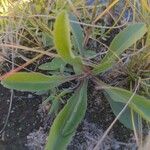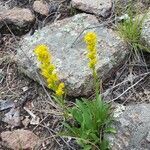Plants (3–)5–10 dm from creeping rhizomes, sometimes with a caudex as well, glabrous throughout; lvs firm, strongly triple-nerved (at least the middle and lower), entire or some (especially the lower) serrate, the lowest ones oblanceolate and conspicuously serrate but mostly soon deciduous, the others slightly to strongly reduced upward, lance-elliptic to broadly linear, tapering to a sessile or obscurely petiolar base, often with axillary fascicles of much reduced lvs; infl paniculiform, with ± strongly recurved-secund branches, mostly short and broad; invol 3–5 mm, its bracts firm, broadly rounded to occasionally acutish; rays 7–13; disk-fls 8–13; receptacle commonly with some bracts near the margin as in no. 25 [Solidago juncea Aiton]; achenes glabrous or sparsely hairy; 2n=18, 36. Prairies and other dry, open or sparsely wooded places; widespread in w. U.S., entering our range from Minn. to Mo., and locally e. to nw. Ind. and s. Ont. Our plants, as here described, are var. fasciculata Holz. (S. glaberrima; S. moritura)
An erect herb. It grows 20-80 cm tall. The stems are green and without hairs.


